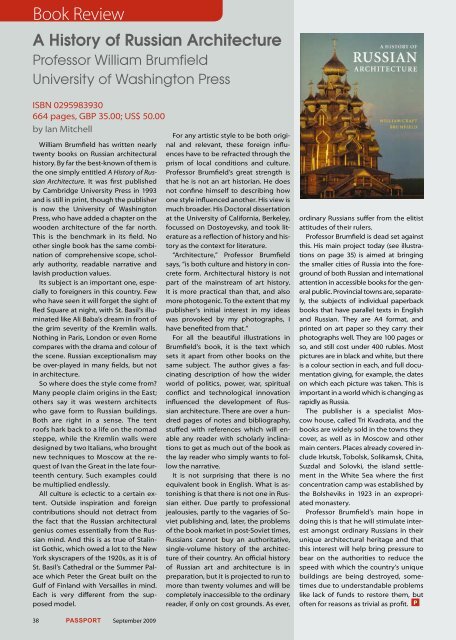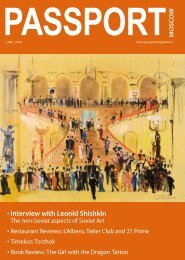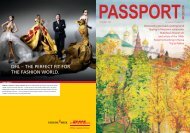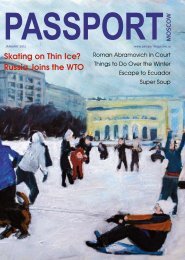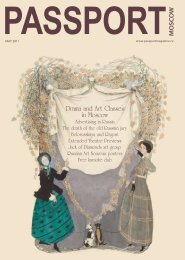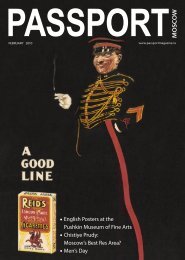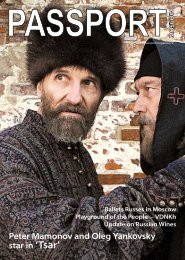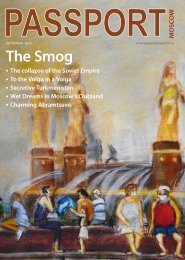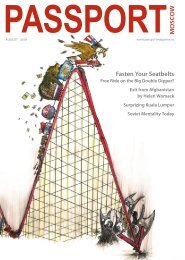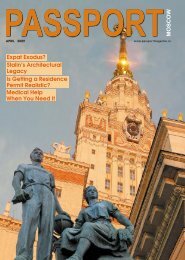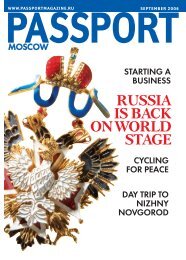Post-Perestroika Warrior - Passport magazine
Post-Perestroika Warrior - Passport magazine
Post-Perestroika Warrior - Passport magazine
You also want an ePaper? Increase the reach of your titles
YUMPU automatically turns print PDFs into web optimized ePapers that Google loves.
Book Review<br />
A History of Russian Architecture<br />
Professor William Brumfield<br />
University of Washington Press<br />
ISBN 0295983930<br />
664 pages, GBP 35.00; US$ 50.00<br />
by Ian Mitchell<br />
William Brumfield has written nearly<br />
twenty books on Russian architectural<br />
history. By far the best-known of them is<br />
the one simply entitled A History of Russian<br />
Architecture. It was first published<br />
by Cambridge University Press in 1993<br />
and is still in print, though the publisher<br />
is now the University of Washington<br />
Press, who have added a chapter on the<br />
wooden architecture of the far north.<br />
This is the benchmark in its field. No<br />
other single book has the same combination<br />
of comprehensive scope, scholarly<br />
authority, readable narrative and<br />
lavish production values.<br />
Its subject is an important one, especially<br />
to foreigners in this country. Few<br />
who have seen it will forget the sight of<br />
Red Square at night, with St. Basil’s illuminated<br />
like Ali Baba’s dream in front of<br />
the grim severity of the Kremlin walls.<br />
Nothing in Paris, London or even Rome<br />
compares with the drama and colour of<br />
the scene. Russian exceptionalism may<br />
be over-played in many fields, but not<br />
in architecture.<br />
So where does the style come from?<br />
Many people claim origins in the East;<br />
others say it was western architects<br />
who gave form to Russian buildings.<br />
Both are right in a sense. The tent<br />
roofs hark back to a life on the nomad<br />
steppe, while the Kremlin walls were<br />
designed by two Italians, who brought<br />
new techniques to Moscow at the request<br />
of Ivan the Great in the late fourteenth<br />
century. Such examples could<br />
be multiplied endlessly.<br />
All culture is eclectic to a certain extent.<br />
Outside inspiration and foreign<br />
contributions should not detract from<br />
the fact that the Russian architectural<br />
genius comes essentially from the Russian<br />
mind. And this is as true of Stalinist<br />
Gothic, which owed a lot to the New<br />
York skyscrapers of the 1920s, as it is of<br />
St. Basil’s Cathedral or the Summer Palace<br />
which Peter the Great built on the<br />
Gulf of Finland with Versailles in mind.<br />
Each is very different from the supposed<br />
model.<br />
September 2009<br />
For any artistic style to be both original<br />
and relevant, these foreign influences<br />
have to be refracted through the<br />
prism of local conditions and culture.<br />
Professor Brumfield’s great strength is<br />
that he is not an art historian. He does<br />
not confine himself to describing how<br />
one style influenced another. His view is<br />
much broader. His Doctoral dissertation<br />
at the University of California, Berkeley,<br />
focussed on Dostoyevsky, and took literature<br />
as a reflection of history and history<br />
as the context for literature.<br />
“Architecture,” Professor Brumfield<br />
says, “is both culture and history in concrete<br />
form. Architectural history is not<br />
part of the mainstream of art history.<br />
It is more practical than that, and also<br />
more photogenic. To the extent that my<br />
publisher’s initial interest in my ideas<br />
was provoked by my photographs, I<br />
have benefited from that.”<br />
For all the beautiful illustrations in<br />
Brumfield’s book, it is the text which<br />
sets it apart from other books on the<br />
same subject. The author gives a fascinating<br />
description of how the wider<br />
world of politics, power, war, spiritual<br />
conflict and technological innovation<br />
influenced the development of Russian<br />
architecture. There are over a hundred<br />
pages of notes and bibliography,<br />
stuffed with references which will enable<br />
any reader with scholarly inclinations<br />
to get as much out of the book as<br />
the lay reader who simply wants to follow<br />
the narrative.<br />
It is not surprising that there is no<br />
equivalent book in English. What is astonishing<br />
is that there is not one in Russian<br />
either. Due partly to professional<br />
jealousies, partly to the vagaries of Soviet<br />
publishing and, later, the problems<br />
of the book market in post-Soviet times,<br />
Russians cannot buy an authoritative,<br />
single-volume history of the architecture<br />
of their country. An official history<br />
of Russian art and architecture is in<br />
preparation, but it is projected to run to<br />
more than twenty volumes and will be<br />
completely inaccessible to the ordinary<br />
reader, if only on cost grounds. As ever,<br />
ordinary Russians suffer from the elitist<br />
attitudes of their rulers.<br />
Professor Brumfield is dead set against<br />
this. His main project today (see illustrations<br />
on page 35) is aimed at bringing<br />
the smaller cities of Russia into the foreground<br />
of both Russian and international<br />
attention in accessible books for the general<br />
public. Provincial towns are, separately,<br />
the subjects of individual paperback<br />
books that have parallel texts in English<br />
and Russian. They are A4 format, and<br />
printed on art paper so they carry their<br />
photographs well. They are 100 pages or<br />
so, and still cost under 400 rubles. Most<br />
pictures are in black and white, but there<br />
is a colour section in each, and full documentation<br />
giving, for example, the dates<br />
on which each picture was taken. This is<br />
important in a world which is changing as<br />
rapidly as Russia.<br />
The publisher is a specialist Moscow<br />
house, called Tri Kvadrata, and the<br />
books are widely sold in the towns they<br />
cover, as well as in Moscow and other<br />
main centers. Places already covered include<br />
Irkutsk, Tobolsk, Solikamsk, Chita,<br />
Suzdal and Solovki, the island settlement<br />
in the White Sea where the first<br />
concentration camp was established by<br />
the Bolsheviks in 1923 in an expropriated<br />
monastery.<br />
Professor Brumfield’s main hope in<br />
doing this is that he will stimulate interest<br />
amongst ordinary Russians in their<br />
unique architectural heritage and that<br />
this interest will help bring pressure to<br />
bear on the authorities to reduce the<br />
speed with which the country’s unique<br />
buildings are being destroyed, sometimes<br />
due to understandable problems<br />
like lack of funds to restore them, but<br />
often for reasons as trivial as profit. P


